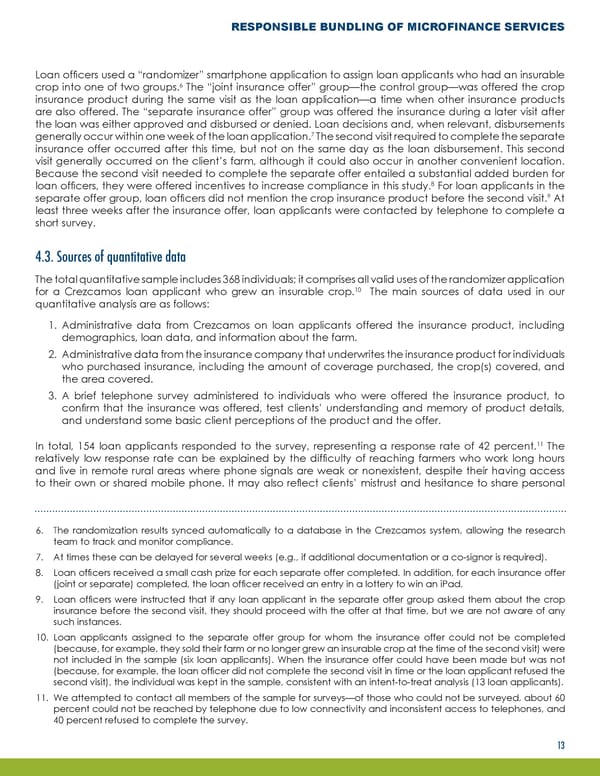RESPONSIBLE BUNDLING OF MICROFINANCE SERVICES Loan officers used a “randomizer” smartphone application to assign loan applicants who had an insurable 6 crop into one of two groups. The “joint insurance offer” group—the control group—was offered the crop insurance product during the same visit as the loan application—a time when other insurance products are also offered. The “separate insurance offer” group was offered the insurance during a later visit after the loan was either approved and disbursed or denied. Loan decisions and, when relevant, disbursements 7 generally occur within one week of the loan application. The second visit required to complete the separate insurance offer occurred after this time, but not on the same day as the loan disbursement. This second visit generally occurred on the client’s farm, although it could also occur in another convenient location. Because the second visit needed to complete the separate offer entailed a substantial added burden for 8 loan officers, they were offered incentives to increase compliance in this study. For loan applicants in the 9 separate offer group, loan officers did not mention the crop insurance product before the second visit. At least three weeks after the insurance offer, loan applicants were contacted by telephone to complete a short survey. 4.3. Sources of quantitative data The total quantitative sample includes 368 individuals; it comprises all valid uses of the randomizer application 10 for a Crezcamos loan applicant who grew an insurable crop. The main sources of data used in our quantitative analysis are as follows: 1. Administrative data from Crezcamos on loan applicants offered the insurance product, including demographics, loan data, and information about the farm. 2. Administrative data from the insurance company that underwrites the insurance product for individuals who purchased insurance, including the amount of coverage purchased, the crop(s) covered, and the area covered. 3. A brief telephone survey administered to individuals who were offered the insurance product, to confirm that the insurance was offered, test clients’ understanding and memory of product details, and understand some basic client perceptions of the product and the offer. 11 The In total, 154 loan applicants responded to the survey, representing a response rate of 42 percent. relatively low response rate can be explained by the difficulty of reaching farmers who work long hours and live in remote rural areas where phone signals are weak or nonexistent, despite their having access to their own or shared mobile phone. It may also reflect clients’ mistrust and hesitance to share personal 6. The randomization results synced automatically to a database in the Crezcamos system, allowing the research team to track and monitor compliance. 7. At times these can be delayed for several weeks (e.g., if additional documentation or a co-signor is required). 8. Loan officers received a small cash prize for each separate offer completed. In addition, for each insurance offer (joint or separate) completed, the loan officer received an entry in a lottery to win an iPad. 9. Loan officers were instructed that if any loan applicant in the separate offer group asked them about the crop insurance before the second visit, they should proceed with the offer at that time, but we are not aware of any such instances. 10. Loan applicants assigned to the separate offer group for whom the insurance offer could not be completed (because, for example, they sold their farm or no longer grew an insurable crop at the time of the second visit) were not included in the sample (six loan applicants). When the insurance offer could have been made but was not (because, for example, the loan officer did not complete the second visit in time or the loan applicant refused the second visit), the individual was kept in the sample, consistent with an intent-to-treat analysis (13 loan applicants). 11. We attempted to contact all members of the sample for surveys—of those who could not be surveyed, about 60 be reached percent could not by telephone due to low connectivity and inconsistent access to telephones, and 40 percent refused to complete the survey. 13
 Responsible Bundling of Microfinance Services Page 15 Page 17
Responsible Bundling of Microfinance Services Page 15 Page 17